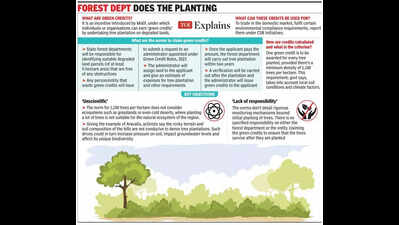- News
- City News
- gurgaon News
- Environmentalists move SC to revise green credit norms, say they may cause more harm than good
Trending
Environmentalists move SC to revise green credit norms, say they may cause more harm than good
Gurgaon: Environmentalists have challenged Green Credit Rules before the Supreme Court, arguing that some guidelines of the policy were "unscientific" and used "subjective" criteria for plantation drives.
People for Aravallis and Rainbow Warriors on March 1 filed an intervention application in an existing writ petition (Ashok Kumar Sharma & others vs Union of India), which had challenged the constitutional validity of amendments made to the Forest (Conservation) Act, 1980.
The latest plea seeks changes in the Green Credit Rules, which were notified by the Union environment ministry on Oct 12, 2023.
The initiative is a reward system that allows individuals or organisations to earn ‘green credits' by paying for planting trees on degraded lands.
The main contention is the guideline, which says that credits will be awarded if there's a minimum density of 1,100 trees planted in one hectare of land.
"Planting 1,100 trees per hectare without scientific basis can harm fragile ecosystems by reducing species diversity, increasing soil resource pressure, impacting hydrological systems, and making plantations more susceptible to pests," said Dr Pia Sethi, an ecologist who is a member of People for Aravallis.
Environmentalists argue that planting trees in grasslands, savannas and shrublands could also lead to loss of wildlife and plant species that are uniquely suited to a specific ecosystem.
"With respect to plantations in grasslands, it is submitted that grasslands are an ecosystem in themselves, and therefore, allowing plantation at 1,100 trees per hectare will have adverse consequences on the species relying on the grasslands for their survival... Converting open grasslands, savannas, and shrublands into plantation forests will result in the loss of unique, endemic, ecologically important, and threatened species which thrive in these ecosystems such as rhinos, blackbucks, great Indian bustard, lesser florican, Nilgiri tahr, etc," the plea read.
According to an MoEF notification on Feb 22, 2024, forest departments of states and Union territories will identify degraded land parcels of at least 5-hectare area that are free from any encumbrances.
To get green credits, a person/organisation will have to file an application to an administrator, who will then assign land. The administrator will give an estimate of tree plantation and other expenses for the applicant to pay. Once the amount is received, the forest department will have to carry out the plantation drive within two years.
The credits will be issued after the plantation is completed.
The plea highlighted shortcomings in these rules and questioned who will be responsible for maintaining the plantation and ensuring that the trees survive in the later years.
The petitioners also allege that the initiative disregards the rights of scheduled tribes and other forest dwellers under the Forest Rights Act, 2006.
"Green Credit Rules seek to identify areas for plantation on largely subjective criteria that are not based on any ecological or scientific foundations… The green credit methodology uses a tree-for-tree approach without considering the ecosystem services provided by open natural ecosystems. For example, is a desert a degraded ecosystem that requires planting over because it comes under the category of open forest or scrub?... It is this unscientific approach that has led to the recent misplaced focus on planting trees in Ladakh…" the plea said.
It also argued that the survival rate of trees after plantation drives is very low and granting green credits to companies after a plantation drive is completed "absolves them of the responsibility of ensuring that the planted trees are maintained, and their survival is ensured for some years".
Citing these objections, the petitioners asked the top court to direct MoEF to hold the entity seeking green credits responsible for survival of planted trees for a specific timeperiod, ensure that no credits are granted till the survival of trees is monitored over a duration, change the condition of planting 1,100 trees per hectare, and avoid plantation drives in open forests, scrubland, wasteland and catchment areas.
Neelam Ahluwalia, founder of People for Aravallis, said it was "critical" to challenge the rules to "protect" the "threatened hill range".
Asked about the plea, retired IFS officer of Haryana cadre MD Sinha told TOI that the Aravalis are only fit for "conservation forestry".
"Neither would the forest department recommend such activities in Aravalis," he said.
Sinha, on the norm for 1,100 trees per hectare, said, "These are guidelines. Area specific recommendations will be made by the forest department. 1,100 plants per hectare will be applicable in high forest areas, and not for arid regions like the Aravalis. Also, for plantation in forest areas, only local species are allowed."
A forest official of the Haryana forest department said on Monday that it has not received any application for green credits since the initiative was launched.
"If any request comes up, then we will select an area that is degraded and a regeneration plan will be made taking into account rainfall, climate condition and soil quality," the official said.
End of Article
FOLLOW US ON SOCIAL MEDIA








